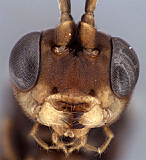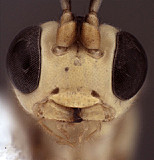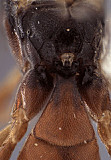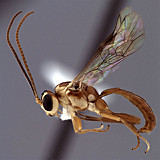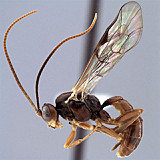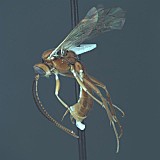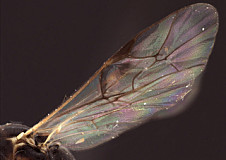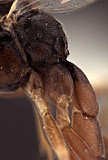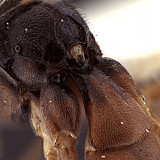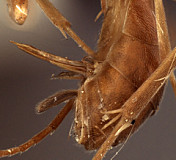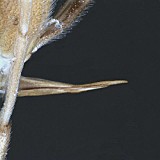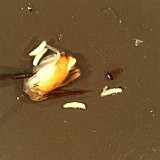Clypeus with ventral margin thick and bluntly rounded, with thin, usually prominent, triangular to rounded tooth laterally in female (Fig. 5), this absent in male (Fig. 6); ventral margin convex; epistomal sulcus distinct throughout, clypeus in profile distinctly angled outwardly from face. Malar space distinct, usually at least half basal width of mandible. Mandible with ventral tooth usually very slightly longer than dorsal tooth, more rarely with dorsal tooth distinctly longer than ventral tooth. Ocelli small, lateral ocellus distinctly shorter than distance between ocellus and eye. Maxillary palp shorter than head height; female antennae varying from about as long as to distinctly shorter than body; first flagellomere with discrete tyloid containing fewer than 15 sensilla. Hypostomal carina joining occipital carina well above base of mandible; occipital carina complete. Dorsal end of epicnemial carina distant from anterior margin of mesopleuron. Notaulus absent to barely indicated as a broad, very shallow depression at anterior margin, not extending posteriorly to level of spiracle. U- to v-shaped groove or notch absent between propodeum and metanotum in lateral view; pleural carina complete, well-developed; propodeal carinae (Figs 8-10) well-developed posteriorly with complete posterior transverse carina and petiolar and posterior-lateral fields, absent or nearly so anteriorly, areola at most indistinct, anterior transverse carina absent, lateral longitudinal carina sometimes weakly indicated. Apical margin of mid tibia weakly to sharply expanded into a distinct tooth similar to that on fore tibia; apical comb on hind tibia not well developed, row of setae present along posterior face, but these widely spaced, not dense as in typical comb; posterior hind tibial spur not exceptionally long (Fig. 11), but at least 7x longer than maximum width at base; tarsal claws completely pectinate. Fore wing (Fig. 7) with areolet present, usually broad; stigma relatively broad, Rs+2r arising at or near midpoint. Hind wing with first abscissa of CU1 distinctly longer than 1cu-a. T1 (Figs 1, 3, 8-10) not long and slender throughout, distinctly broadening posteriorly, usually without dorsal carinae, but with weakly elevated, rounded ridges in at least one species; usually with shallow but distinct basal depression at dorsal tendon attachment; dorsal-lateral carina extending from spiracle to apex of T1 in some species, weak to absent in others; glymmae on each side meeting on the midline posterior to dorsal tendon attachment, deep, usually tall, separated at midline by translucent partition. T2 thyridium absent; laterotergites of T2 and T3 completely separated by creases. Ovipositor (Figs. 12-14) straight, relatively broad at base, with shallow, very broad subapical notch, the lower valves much deeper than upper valves over apical 0.6; ovipositor sheath long, narrow, slender, somewhat rounded distally. Male parameres broad, rectangular in dorsal view, never narrowly attenuate distally; aedeagus rounded and clubbed distally.
The description given above is based on four of the Nearctic species.
1.
Trematopygodes lateral h...
Trematopygodes lateral habitus, female.
↰
↴
2.
Trematopygodes lateral h...
Trematopygodes lateral habitus, female.
↰
↴
3.
Trematopygodes lateral h...
Trematopygodes lateral habitus, male
↰
↴
4.
Trema...
Trematopygodes dorsal habitus
↰
↴
5.
Trematopygodes face, ...
Trematopygodes face, female.
↰
↴
6.
Trematopygodes face, m...
Trematopygodes face, male.
↰
↴
8.
Trematopygodes...
Trematopygodes propodeum and T1 in profile
↰
↴
9.
Trematopygodes propodeum...
Trematopygodes propodeum and T1
↰
↴
10.
Trematopygodes ...
Trematopygodes propodeum and T1
↰
↴
11.
Trematopy...
Trematopygodes hind leg tibial spurs
↰
↴
12.Trematopygodes ovipositor
13.
Trematopygodes oviposito...
Trematopygodes ovipositor
↰
↴
14.
Trematopygodes oviposito...
Trematopygodes ovipositor and large eggs
↰
↴

